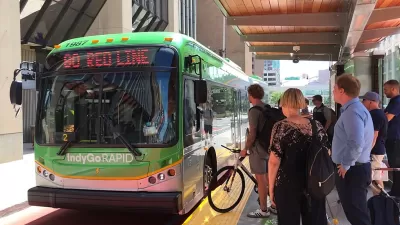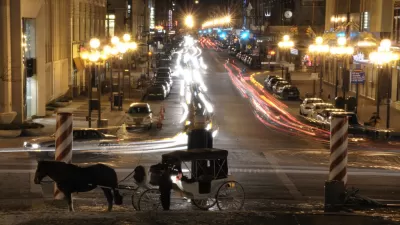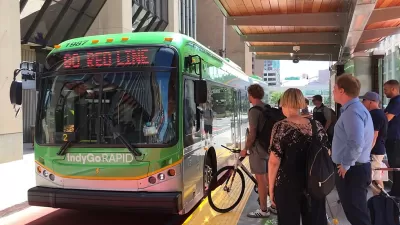IndyGo transit officials are required to match transit income tax revenue with funding from private sources, but haven't yet met that end of the bargain. A new state law would hold IndyGo accountable to those requirements.

"The Indiana Senate voted Thursday [February 27] to put teeth in a 2014 state law that required IndyGo to raise private dollars to help finance its mass transit operations, including the Red Line—something it has not done to date," reports Lesley Weidenbener.
"IndyGo officials say the legislation—which still requires final votes in the House and Senate—could significantly jeopardize its operations and its ability to build the planned Blue and Purple rapid transit lines," according to Weidenbener.
A 2014 law that, according to Weidenbener, "authorized a 0.25-percentage-point increase in the city’s income tax rate to fund IndyGo operations and new services," is the source of the controversy. That law required IndyGo to provide a 10 percent match of tax revenue with funding from private sources.
"The tax went into effect in October 2017 and is generating about $60 million per year. [State Senator Aaron] Freeman said that means IndyGo would need to raise about $6 million per year to meet the law’s threshold, but the agency has so far not raised any private money," according to Weidenbener. The 2014 law didn't include penalties if the city failed to meet that requirement, so the law proposed by Freeman last week would "require the state to withhold 10% of IndyGo’s local income tax revenue in years that it failed to meet the private funding threshold," according to Weidenbener.
Planetizen documented some of the long process of the city's adoption of the transit income tax, from approval by voters, to implementation delays and eventual approval by the City Council, to initial ridership success and ambitious plans enabled by the new revenue stream.
FULL STORY: Bill could strip IndyGo of millions of dollars, halt future work on Purple, Blue lines

Montreal Mall to Become 6,000 Housing Units
Place Versailles will be transformed into a mixed-use complex over the next 25 years.

Planetizen Federal Action Tracker
A weekly monitor of how Trump’s orders and actions are impacting planners and planning in America.

Four Reasons Urban Planners Can’t Ignore AI
It’s no longer a question of whether AI will shape planning, but how. That how is up to us.

Bend, Deschutes County Move to Restrict Major Homeless Encampment
City and county officials are closing off portions of an area known as Juniper Ridge where many unhoused residents find shelter, hoping to direct people to housing and supportive services.

High Housing Costs Driving Down Transit Ridership in LA
When neighborhoods gentrify and displace lower-income residents, transit ridership suffers, new research shows.

Iowa Legalizes Accessory Dwelling Units
A new law will allow property owners to build ADUs on single-family lots starting on July 1.
Urban Design for Planners 1: Software Tools
This six-course series explores essential urban design concepts using open source software and equips planners with the tools they need to participate fully in the urban design process.
Planning for Universal Design
Learn the tools for implementing Universal Design in planning regulations.
City of Mt Shasta
City of Camden Redevelopment Agency
City of Astoria
Transportation Research & Education Center (TREC) at Portland State University
City of Camden Redevelopment Agency
Municipality of Princeton (NJ)
Regional Transportation Commission of Southern Nevada





























